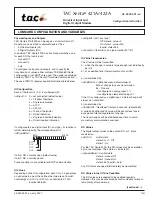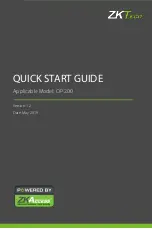
2
As a contact sensor
Depending on the selected IO configuration, up to four external
contacts are possible. As a contact sensor, this device allows wireless
monitoring of garage doors, gates, windows, mailboxes, doorbells,
and pool or spa covers (along with other contact sensor monitoring
applications you integrate or devise). These functions appear in a
Control4 system as contact sensor inputs, which can trigger home
automation events.
The internal contact is a magnetic reed switch. To use this internal
contact, the Z2IO should be mounted so that the indention (along
the same edge as the identify button) comes in close proximity to a
mounted magnet (not included) in a fully closed state (door is closed).
When the door opens, the magnetic connection is lost, and that state
change is pushed to the system.
Contact and relay wiring options
There are five wiring options for contacts and relays. After they are
physically wired (as explained below), the correct option must be
manually selected on the
Properties
tab using the
IO Properties
drop-
down box.
Pins
PWR
Cm
T
C4
C3
Cm
C2
C1
O
ptions
1
+
Cm
T
R2 (SPST)
R2 (SPST)
Cm
R1 (SPST)
R1 (SPST)
2
C4
C3
C2
C1
3
C2
C1
R1 (SPST)
R1 (SPST)
4
R2 (SPDT)
R2 (SPDT)
R1 (SPDT)
R1 (SPDT)
5
R2 (DPST)
R2 (DPST)
R1 (DPST)
R1 (DPST)
R# = Relay, C# = Contact, Cm = Common ground (-), T = Thermistor,
SPST = Single pole single throw, SPDT = Single pole double throw,
DPST = Double pole single throw
Option 1:
Two Relays using R1, R2—Two independent, single pole
single throw (SPST) relays. Each relay controls a single circuit.
• Relay 1 is wired to pins C1 and pin C2.
• Relay 2 is wired to pins C3 and pin C4
Option 2:
Four Contacts using C1, C2, C3, C4—Four independently
sensed circuits.
• Contact 1 is wired to pin C1 and pin Cm (Common).
• Contact 2 is wired to pin C2 and pin Cm (Common).
• Contact 3 is wired to pin C3 and pin Cm (Common).
• Contact 4 is wired to pin C4 and pin Cm (Common)
Option 3:
One Relay (SPST) and Two Contacts using R1 and C1, C2.
• Relay 1 is wired to pin C1 and pin C2.
• Contact 1 is wired to pin C3 and pin Cm (Common).
• Contact 2 is wired to pin C4 and pin Cm (Common).
Option 4:
One Relay using R1 and R2 (SPDT)—The two relays
operate together to simulate a single SPDT (single pole double
throw) relay. However, unlike a true SPDT relay, both relays will
open during a power failure.
• Relay 1 is wired to pin C1 and pin C2.
• Relay 2 is wired to pin C3 and pin C4.
Option 5:
One Relay using R1 and R2 (DPST)—The two relays
operate together to simulate a single DPST (double pole single
throw configuration) relay. However, unlike a true DPST relay,
both relays will open during a power failure.
• Relay 1 is wired to pin C1 and pin C2.
• Relay 2 is wired to pin C3 and pin C4.
As a thermistor and humidistat
The device contains an integrated thermistor and humidistat, as well as
a connection for an external thermistor, allowing it to be used almost
anywhere to report environmental conditions or to inform the climate
control system. The thermistor senses temperatures from 0 to 40 °C
(32 to 104 °F), and the humidistat senses humidity from 5% to 90%. The
device checks the temperature and humidity every five seconds. If
the temperature has changed more than 0.28 °C (0.5 °F), the device
reports the new temperature. If the humidity has changed more than
0.5%, the device reports the new humidity percentage.
Data from the integrated thermistor and humidistat is always
available, regardless of the selected IO configuration.
Notes:
• The humidity and internal and external temperature
outputs can be connected (bound) to the Control4
Wireless Thermostat by Aprilaire (C4-THERM).
• A value of -40° in the Remote Temperature field could
indicate either a negative temperature or that no remote
thermistor is connected.
• The integrated humidistat will return a zero value after
the device is rebooted until the actual humidity value can
be reported.
• To display the temperature and/or humidity in Navigator,
add the “Temperature Display Driver (OS 2.10+)” to the
project and connect the driver’s temperature driver to the
Z2IO.
• Given the variations in temperature and humidity
measurements and environments, it may be necessary
to independently test and verify the local and remote
temperature and humidity. The properties
Local
Temperature Offset
,
Remote Temperature Offset
, and
Local Humidity Offset
can be used for this purpose.
Important safety instructions
Caution!
You should install this device in accordance with all
national and local electrical codes.
Caution!
Improper use or installation of this device can result
in loss of and damage to property.
Caution!
If this product is used as a means to open and
close a garage door, gate, or similar device, use safety or
other sensors to ensure safe function. Follow appropriate
regulatory and safety standards governing project design
and installation. Failure to do so may result in property
damage or personal injury.
Important: This product is not intended for direct connections
to AC mains (120V/220V). Refer to the specifications.
Important: You must operate this device in accordance with
the instructions and specifications in this installation guide.
Important: Using this product in any manner other than
outlined in this document voids your warranty. Also, Control4
is
not
responsible or otherwise liable in any way for any
damage resulting from the misuse of this product. See
ctrl4.co/warranty
for details.

























